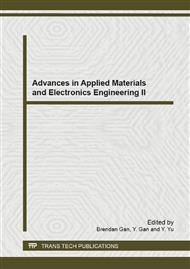[1]
Terzaghi K and Peck R B. Soil Mechanics in Engineering Practice, Second edition, 108. Chichester, Wiley. (1948).
Google Scholar
[2]
Castro G. Liquefaction of Sands. PhD thesis, Harvard Soil Mechanics Series, No. 81, Harvard University, Cambridge, Mass. (1969).
Google Scholar
[3]
Castro G, Poulos S, France J and Enos J. Liquefaction Induced by Cyclic Loading, Geotechnical Engineering, Inc. Reporter Submitted to National Science Foundation, March. (1982).
Google Scholar
[4]
Casagrande A. Liquefaction and Cyclic Mobility of Sands – a critical review. Harvard Soil Mechanics Series, No. 88, Harvard University, Cambridge, Mass. (1976).
Google Scholar
[5]
Kramer S L. Geotechnical Earthquake Engineering, Pentice Hall, Upper Saddle River, New Jersey. (1996).
Google Scholar
[6]
Jerry A Yamamuro and Poul V Lade. Static Liquefaction of Very Loose Sands. Canadian Geotechnical Journal, 34(6). (1997).
DOI: 10.1139/t97-057
Google Scholar
[7]
Jerry A Yamamuro and Poul V Lade. Steady-state Concepts and Static Liquefaction of Silty Sands. ASCE Journal of Geotechnical and Geoenvironmental Engineering, 124(9): 986-877. (1998).
DOI: 10.1061/(asce)1090-0241(1998)124:9(868)
Google Scholar
[8]
Luan Maotian and Nian Tingkai. A Case Review of Landslide of Fill Slopes at Sau Mau Ping of Hong Kong in 1976. Journal of Prevention and Mitigation Engineering, 23(1): 114-117. (2003).
Google Scholar
[9]
Zhao Chunhong and Dai Fuchu. Study on Failure Mechanism of a fill slope in Shenzhen. The Chinese Journal of Geotechnical Hazard and Control, 18(2): 1-8. (2007).
Google Scholar
[10]
Jerry A Yamamuro and Poul V Lade. Static Liquefaction of Very Loose Sands. Canadian Geotechnical Journal, 34(6): 905-917. (1997a).
DOI: 10.1139/t97-057
Google Scholar
[11]
Jerry A Yamamuro and Poul V Lade. Effects of Nonplastic Fines on Static Liquefaction of Sands. Can. Geotech. J. 34: 918-928. (1997).
DOI: 10.1139/t97-052
Google Scholar
[12]
Zlatovic S and Ishihara K. Normalized Behavior of Very Loose Non-plastic Soils: Effects of Fabric. Soils and Foundations, 37(4): 47~56. (1997).
DOI: 10.3208/sandf.37.4_47
Google Scholar
[13]
Yoichi Okura, Hikaru Kitahara, Hirotaka Ochiai, Toshiaki Sammori and Akiko Kawanami. Landslide Fluidization Process by Flume Experiments. Engineering Geology, 66: 65-78. (2002).
DOI: 10.1016/s0013-7952(02)00032-7
Google Scholar
[14]
Moriwaki H, Inokuchi T, Hattanji T, Sassa K, Ochiai H, Wang G. Failure Processes in a Full-scale Landslide Experiment Using a Rainfall Simulator. Landslide: 277~288. (2004).
DOI: 10.1007/s10346-004-0034-0
Google Scholar
[15]
W.A. Take, M.D. Bolton, P.C.P. Wong, F.J. Yeung. Evaluation of Landslide Triggering Mechanisms in Model Fill Slopes. Landslides: 173-184. (2004).
DOI: 10.1007/s10346-004-0025-1
Google Scholar
[16]
B. GRATCHEV Ivan, SASSA Kyoji, I. OSIPOV Victor, N. SOKOLOV Viatcheslav. The liquefaction of clayey soils under cyclic loading. Engineering Geology, 86: 70-84. (2006).
DOI: 10.1016/j.enggeo.2006.04.006
Google Scholar
[17]
Nanjing Hydraulic Research Institute, Specification of Soil Test SL 237-1999. (1999).
Google Scholar


